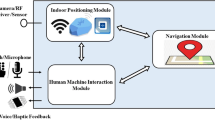Abstract
The problem of determining the distance from an arbitrary point to the center of interference band with a known profile from the data distorted by random noise is formulated. At the final stage in the developed algorithm, the Wiener–Kolmogorov filtering is used. The numerical simulation shows that the averaged error of estimate computed by the proposed method is 50–75% less than the estimate obtained without noise. The results of processing experimental data also confirm the efficiency of the proposed method.




Similar content being viewed by others
REFERENCES
C. M. West, Holographic Interferometry (New York, John Wiley and Sons, 1979).
V. A. Arbuzov, E. V. Arbuzov, N. A. Dvornikov, Yu. N. Dubnishchev, V. G. Nechaev, and E. O. Shlapakova, ‘‘Optical diagnostics of vortex ring-flame interaction,’’ Optoelectron., Instrum. Data Process. 52, 161–166 (2016). https://doi.org/10.3103/S8756699016020084
A. Ya. Aleksandrov and M. Kh. Akhmetzyanov, Polarization-Optical Methods of Solid Mechanics (Nauka, Moscow, 1973).
S. I. Gerasimov, ‘‘Photoelastic method for analyzing residual stresses in compact disks,’’ J. Appl. Mech. Tech. Phys. 45, 453–456 (2004).
I. A. Razumovskii, Interference-Optical Methods of Solid Mechanics (Moscow, Mosk. Gos. Tekh. Univ., 2007).
L. V. Stepanova and V. S. Dolgikh, ‘‘Digital processing of optoelectronic measurement results: Photoelasticity method and its application for determining coefficients of multiparametric Williams asymptotic decomposition of stress field,’’ Vestn. Samar. Gos. Tekh. Univ., Ser. Phys.-Mat. Nauki 21, 717–735 (2017).
V. S. Dolgikh, L. V. Stepanova, and V. A. Turkova, ‘‘Digital processing of optoelectronic measurement results (photoelasticity method) with application to problems of fracture mechanics: Multiparametric stress field analysis near crack tip,’’ in Sb. Tr. III Int. Conf. and Young Sci. School Information Technologies and Nanotechnologies (ITNT 2017) (Novaya Tekhnika, Samara, 2017), pp. 1425–1428.
G. N. Albaut, Nonlinear Photoelasticity with Application to Problems of Fracture Mechanics (NGASU, Novosibirsk, 2002).
G. N. Albaut, E. P. Matus, and M. V. Tabanyukhova, ‘‘Studying stress state of disperse-reinforced beams using photoelasticity method,’’ Deform. Razrushenie Mater., No. 4, 46–49 (2009).
K. Ramesh, Digital Photoelasticity: Advanced Techniques and Applications (Spinger, Berlin, 2000). https://doi.org/10.1007/978-3-642-59723-7
T. E. Gerasimova ‘‘Digital processig of images obtained using interference-optical methods of solid mechanics,’’ Vestn. Samar. Gos. Univ., Ser. Mech. 125 (3), 73–87 (2015).
A. N. Kosygin and L. N. Kosygina, ‘‘Digital processing of experimental interferograms obtained by photoelasticity method,’’ Vestn. Samar. Univ., Estestv.-Nauch. Ser. 25 (2), 75–91 (2019).
A. W. Hendry, Elements of Experimental Stress Analysis: Structures and Solid Body Mechanics Division (Pergamon, New York, 2013).
V. I. Guzhov and S. P. Il’inykh, Optical Measurements: Computer Interferometry (Yurait, Moscow, 2019).
T. H. Baek, M. S. Kim, and D. P. Hong, ‘‘Fringe analysis for photoelasticity using image processing techniques,’’ Int. J. Software Eng. Its Appl. 8 (4), 91–102 (2014).
K. V. N. Surendra and K. R. Y. Simha, ‘‘Digital image analysis around isotropic points for photoelastic pattern recognition,’’ Opt. Eng. 54, 081209 (2015). https://doi.org/10.1117/1.OE.54.8.081209
A. B. Sergienko, Digital Signal Processing (Piter, St. Petersburg, 2007).
S. Alsiya, J. C. Leksmi, J. B. P. Priya, and R. C. Mehta, ‘‘Image processing algorithm for fringe analysis in photoelasticity,’’ Scholars J. Eng. Technol. 2016. 4, 325–328. https://doi.org/10.21276/sjet.2016.4.7.5
N. G. Preobrazhenskii and V. V. Pikalov, Instable Problems of Plasma Diagnostics (Nauka, Novosibirsk, 1982).
S. Alsiya, J. C. Leksmi, J. B. P. Priya, and R. C. Mehta, ‘‘Image processing algorithm for fringe analysis in photoelasticity,’’ Scholars J. Eng. Technol. 2016. 4, 325–328. https://doi.org/10.21276/sjet.2016.4.7.5
Author information
Authors and Affiliations
Corresponding authors
Additional information
Translated by E. Oborin
About this article
Cite this article
Likhachev, A.V., Tabanyukhova, M.V. Assessing the Distance from a Given Point to the Maximum of Interference Band. Optoelectron.Instrument.Proc. 57, 250–256 (2021). https://doi.org/10.3103/S8756699021030109
Received:
Revised:
Accepted:
Published:
Issue Date:
DOI: https://doi.org/10.3103/S8756699021030109




